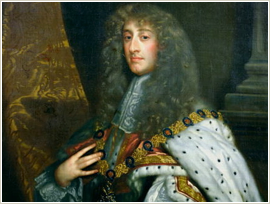Adventures of the Stuart Papers
James II and VII (1633–1701) was King of England and Ireland as James II and King of Scotland as James VII, from 6 February 1685 until he was deposed in the Glorious Revolution of 1688. He was the last Roman Catholic monarch to reign over the Kingdoms of England, Scotland and Ireland.
Even before 1800, the Prince Regent (Prince of Wales, 1762-1830, became King George IV in 1820) was aware that there existed a large collection of papers which James II had taken with him when he left England for France in exile and kept them with him throughout his life. The Prince of Wales was determined to acquire them and after years of searching, his agent, Sir. J. C. Hippisley, located the bulk of the papers of James II in Rome. The papers had passed to James’ son, the Jacobite King James III, who eventually passed them on to his two sons, Charles Edward Stuart (Bonnie Prince Charlie) and Henry Benedict Stuart. Having no legitimate heir at the time of his death, Prince Charles left most of his property, including his share of the Stuart papers to his illegitimate daughter, Charlotte, by his mistress, Clementina Walkinshaw. He had made her legitimate and ennobled her as the Duchess of Albany. Upon her death in 1789, the Benedictine Abbé James Waters, who was her executor, took possession of the papers and kept them in his home in Rome.
In 1804, when the Prince of Wales learned that the papers had been located, he authorized his agent to negotiate their purchase and the deal was concluded in 1805. The papers were crated and delivered by Hippisley to Mr. Richard Bartram, the English Consul at Civita Vecchia, a sea port near Rome. From there, Admiral Lord Nelson was to collect them and return them to England. However, Nelson was not able to get to Civita Vecchia before the Battle of Trafalgar in October 1805, and thus the papers remained hidden there whilst awaiting a new courier. In July 1806, Lord Collingwood attempted to complete Nelson’s mission and sent a brig under the command of Captain Raitt to Civita Vecchia to collect the crates of Stuart papers. But the Napoleonic Wars intervened and twelve days before Captain Raitt arrived, the French had occupied the town, and the British brig was not allowed to land. Another attempt in September by Captain Raitt to communicate with Bartram was also unsuccessful. Captain Raitt will surely be Captain William Raitt, commander of the Scout, who played a heroic and active role in the Napoleonic Wars (see Military Raitts – The Sailors.)
Eventually, the crates were shipped to Leghorn (Livorno, a port in the North of Italy), where they were loaded on a Tunisian vessel bound for Tunis. From Tunis, the crates were sent on to Malta, where they were taken aboard a British vessel and were finally delivered to the Prince of Wales in London in 1810 who stored them in his library at Carlton House. In 1822, the Prince of Wales, as George IV, was finally able to locate and purchase the other half of James II’s papers which had been in the possession of Henry Benedict Stuart, Cardinal Duke of York, who lived in Frascati, outside Rome. Those crates of papers came to England by a much less circuitous route than had the portion acquired in 1805. All of the Calendar of the Stuart Papers belonging to the King are now part of the British Royal Collection and are preserved in Windsor Castle.
The papers, of course, refer mainly to activities during the reign of James II, but also contain other papers from James III and his two sons and additional Stuart writings. Volume 1 gives the full story of the acquisition of the papers by the Prince Regent, as well as a description of the contents and brings the Calendar of events to the end of February 1716 when the rising of 1715 was practically over, James and the Duke of Mar had escaped to France, and the Jacobites in Scotland were dispersing. In volume 2, and subsequent volumes, there are several mentions of a Lieutenant Alexander Rait – without the context we could gather that he was presumably a Jacobite sympathizer, possibly an officer in the Jacobite army and perhaps an equerry of some sort to the Duke and Duchess of Mar. In fact, Alexander was the Secretary to the Earl of Mar from about 1703-1728 and his story can be found on his own biographical page.
Wednesday, 4 September 2013

